
Jackson's Mill is a former grist mill in Lewis County, West Virginia, near the city of Weston. The mill, listed on the National Register of Historic Places in 1972, is now the centerpiece of a state-owned museum property. It is significant as a well-preserved early grist mill, and as the boyhood home of Stonewall Jackson, a renowned Confederate general in the American Civil War.

Piney Grove at Southall's Plantation is a property listed on the National Register of Historic Places in Holdcroft, Charles City County, Virginia. The scale and character of the collection of domestic architecture at this site recalls the vernacular architectural traditions of the eighteenth, nineteenth and twentieth centuries along the James River.

Staats Mill Covered Bridge, also known as Tug Fork Covered Bridge, is a historic wooden covered bridge near Ripley in Jackson County, West Virginia, United States. Built in 1887, the Staats Mill Covered Bridge originally crossed the Tug Fork of Big Mill Creek and was named for Enoch Staats' water-powered mill.

George Washington's Gristmill was part of the original Mount Vernon plantation, constructed during the lifetime of the United States' first president. The original structure was destroyed about 1850. The Commonwealth of Virginia and the Mount Vernon Ladies’ Association have reconstructed the gristmill and the adjacent distillery. The reconstructed buildings are located at their original site three miles (5 km) west of Mount Vernon proper near Woodlawn Plantation in Alexandria, Virginia. Because the reconstructed buildings embody the distinctive characteristics of late eighteenth century methods of production and are of importance to the history of Virginia, the site is listed on the National Register of Historic Places despite the fact that the buildings are not original.
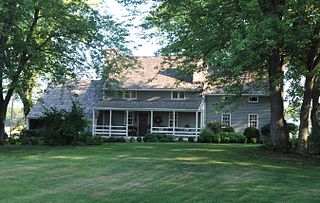
The Thomas Brown House in Inwood, West Virginia, was built about 1741 as a log cabin for Thomas Brown, a Quaker farmer. Brown was one of the first to grow fruit in an area where orchardry would become a major agricultural industry. The house is the oldest known dwelling in Berkeley County.

Fort Gaddis is the oldest known building in Fayette County, Pennsylvania and the second oldest log cabin in Western Pennsylvania. It is located 300 yards (270 m) east of old U.S. Route 119, near the Route 857 intersection in South Union Township, Fayette County, Pennsylvania. Fort Gaddis was built about 1769-74 by Colonel Thomas Gaddis who was in charge of the defense of the region, and his home was probably designated as a site for community meetings and shelter in times of emergency, hence the term "Fort Gaddis," probably a 19th-century appellation. It is a 1 1/2-story, 1-room log structure measuring 26 feet long and 20 feet wide.
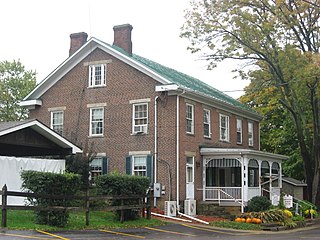
Inn at Fowlerstown, also known as Drover's Inn, is a historic hotel located near Wellsburg in Brooke County, West Virginia, United States. The inn was built between 1848 and 1851, and is a 2½-story brick building in the Greek Revival style. The property also includes a two-story log house (1820) and frame cottage that pre-date the inn. Contributing outbuildings are a small clapboard well house, chicken coop, and privy. Before 1938, the inn housed a general store and post office that served the small village of Fowlerstown. The village grew up around along Washington Pike at the grist mill established by William Fowler.

Halfway House, also known as the Tyree Tavern, is a historic inn and tavern located at Ansted, Fayette County, West Virginia. It is a two-story, log and frame building with a gable roof measuring 50 feet long and 20 feet deep. The original log section was built prior to 1810. It was expanded to its present configuration about 1827. It served as a stage coach stop on the James River and Kanawha Turnpike. Notable guests included Daniel Webster, Henry Clay, and John Breckenridge. It also was headquarters of the Chicago Gray Dragoons during the American Civil War. It was listed on the National Register of Historic Places in 1978.

North River Mills Historic District is a national historic district located at North River Mills, Hampshire County, West Virginia. The district encompasses 25 contributing buildings and five contributing sites. The district lies along Hiett Run, which empties into the North River, a tributary of the Cacapon River. It has become an industrial ghost town, now visited only by summer residents and tourists. The contributing buildings include the Hiett House with shed and privy; Croston House and barn ; North River Mills Grocery ; Shanholtz House, also known as North River Mills Society for Antiquarian Arts and the Diffusion of Knowledge; North River Mills School ; Miller House and associated outbuildings; United Methodist Church ; Kump House ; and the Moreland House. Contributing sites are the cemetery associated with the Kump House, Miller Mill Site, Shanholtz Mill Site, mill pond, and millrace.

Cooper's Rock State Forest Superintendent's House and Garage is a historic home and garage located at Cooper's Rock State Forest near Morgantown, Monongalia County, West Virginia. The house was built between 1938 and 1940, and is a two-story, symmetrical log building, measuring 35 feet by 43 feet. Also on the property is a contributing garage also of log construction. Both buildings were built by the Civilian Conservation Corps, CCC camp number 3527, Camp Rhododendron.

Middle Mountain Cabins are a set of three historic cabins located in the Monongahela National Forest near Wymer, Randolph County, West Virginia. They were built in 1931, and consist of the Main Cabin and Cabins 1 and 2. The Main Cabin is a one-story, rectangular, stained log building measuring approximately 22 feet by 20 feet. It has a gable roof and full-length porch. Cabins 1 and 2 are mirror-images of each other. They are one-story, frame buildings with gable roofs measuring approximately 25 feet by 14 feet. They were built to provide quarters for fire lookouts and to serve as a base for conducting other Forest Service operations. They have since been converted for recreational use, and are available for rental as a group.
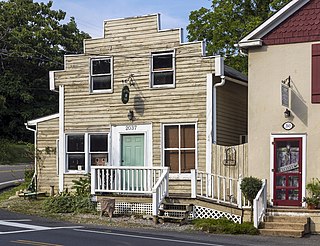
Millwood Commercial Historic District is a national historic district located at Millwood, Clarke County, Virginia.

Burwell-Morgan Mill, also known as the Millwood Mill, is a historic grist mill located at Millwood, Clarke County, Virginia. It was built about 1785 by Gen. Daniel Morgan and Lt. Col. Nathaniel Burwell, who both served in the American Revolution. Burwell was the project's financier and Morgan managed the construction. The project overseer was L.H. Mongrul, whose initials and the date 1782 are carved in a stone in the mill's wall. The mill operated until the 1950s. In 1964 it was donated to the Clarke County Historical Association, which finished restoration in 1970 and operates the mill as a museum.
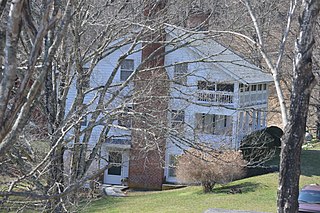
Brookside Farm and Mill is a historic grist mill and farm complex located at Independence, Grayson County, Virginia. The Brookside Mill was built in 1876, and is a three-story, three bay by three bay, heavy timber frame building measuring 30 feet by 35 feet. The principal dwelling was built in 1877, and is a two-story, three bay, frame building with a central passage plan. Other contributing buildings and structures include a brick spring house, brick smokehouse, log corn crib, frame hen house, miller's cabin, the miller's cottage or Graham House, a frame service station / garage (1918), and concrete dam (1914) and earthen mill race.
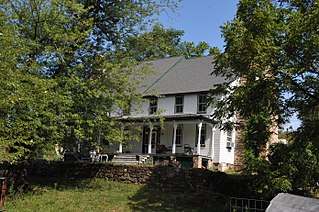
Snodgrass Tavern is an historic tavern located near Hedgesville in Berkeley County, West Virginia. The structure was built in stages beginning around 1742, and is one of the oldest buildings in West Virginia still standing. It is uncertain when the structure became a tavern; but according to Early Hedgesville Chronicles 1720-1947, by William Moore, an account of Robert Snodgrass's wife, Susannah and their first daughter, baby Elizabeth describes it having been used as a tavern during the Indian wars at the brink of the French and Indian War. Specifically, they hid beneath the floors of the tavern, while the Indians drank and fought above. The tavern lasted until 1847, when the property was sold as a private residence. The structure and surrounding property is listed on the National Register of Historic Places.

Mauck's Meetinghouse, also known as Mill Creek Church, is a historic Mennonite-Baptist meeting house located at Hamburg, Page County, Virginia. It was built between 1795 and 1800, and is a 1 1/2-story, planked log structure measuring approximately 36 feet by 29 feet. The building was remodeled about 1830, with the addition of weatherboard siding and interior balconies. The entrances feature raised six-panel Federal doors and the architrave is a simple one-section molding.

Bush Mill, also known as Bond Roller Mill, is a historic grist mill located near Nickelsville, Scott County, Virginia. It was built in 1896, and is a three-story, log and timber frame building on a limestone foundation. It has a front gable roof sheathed in metal. It measures 39 feet, 9 inches by 30 feet, 4 inches. The mill has a 24-foot (diameter) and 4 feet wide overshot steel waterwheel added in the 1920s, which is intact and remains functional. The building is maintained by the Nickelsville Ruritan Club.

Old Pine Church, also historically known as Mill Church, Nicholas Church, and Pine Church, is a mid-19th century church located near to Purgitsville, West Virginia, United States. It is among the earliest extant log churches in Hampshire County, along with Capon Chapel and Mount Bethel Church.

Hebron Church is a mid-19th-century Lutheran church in Intermont, Hampshire County, in the U.S. state of West Virginia. Hebron Church was founded in 1786 by German settlers in the Cacapon River Valley, making it the first Lutheran church west of the Shenandoah Valley. The congregation worshiped in a log church, which initially served both Lutheran and Reformed denominations. Its congregation was originally German-speaking; the church's documents and religious services were in German until 1821, when records and sermons transitioned to English.

The Missouri Lumber and Mining Company (MLM) was a large timber corporation with headquarters and primary operations in southeast Missouri. The company was formed by Pennsylvania lumbermen who were eager to exploit the untapped timber resources of the Missouri Ozarks to supply lumber, primarily used in construction, to meet the demand of U.S. westward expansion. Its primary operations were centered in Grandin, a company town it built starting c. 1888. The lumber mill there grew to be the largest in the country at the turn of the century and Grandin's population peaked around 2,500 to 3,000. As the timber resources were exhausted, the company had to abandon Grandin around 1910. It continued timber harvesting in other parts of Missouri for another decade. While some of the buildings in Grandin were relocated, many of the remaining buildings were listed on the National Register of Historic Places in 1980 as part of the state's historic preservation plan which considered the MLM a significant technological and economic contributor to Missouri.





















